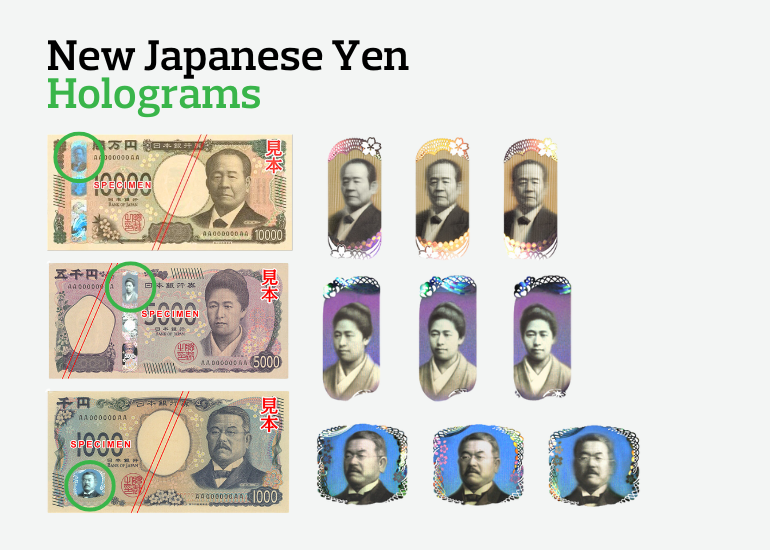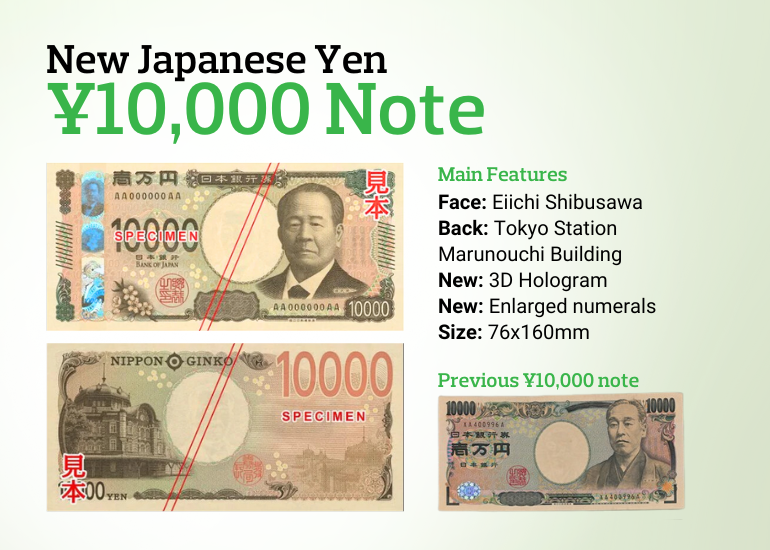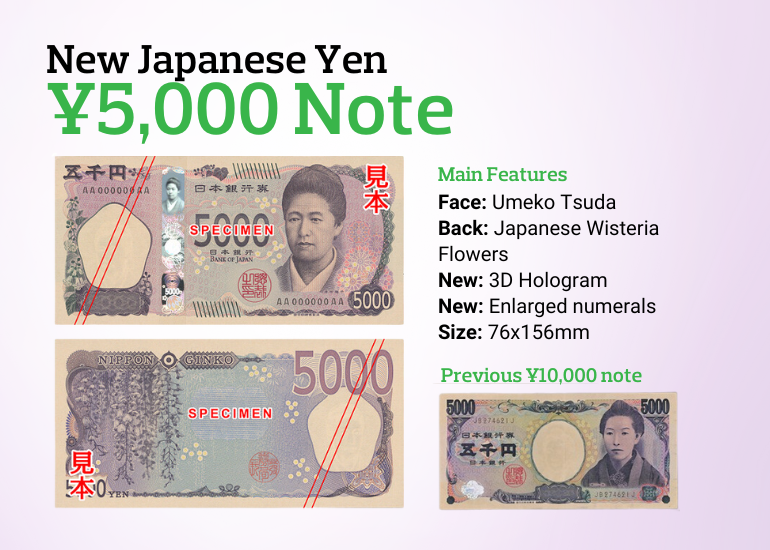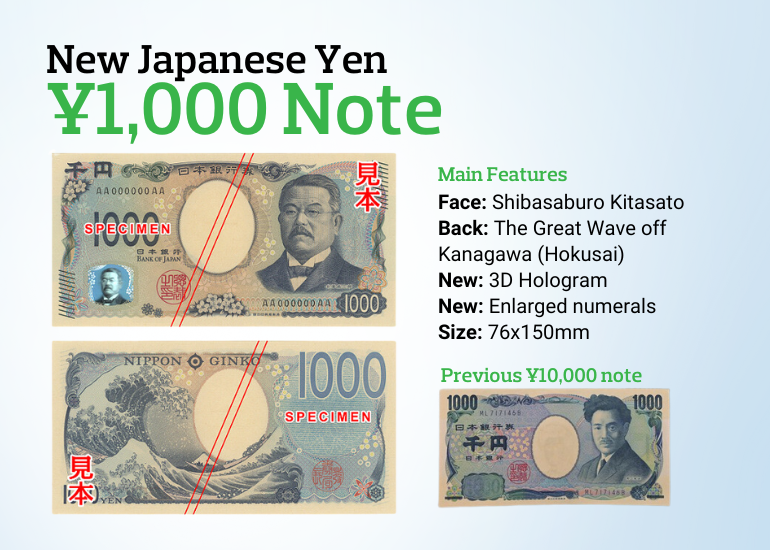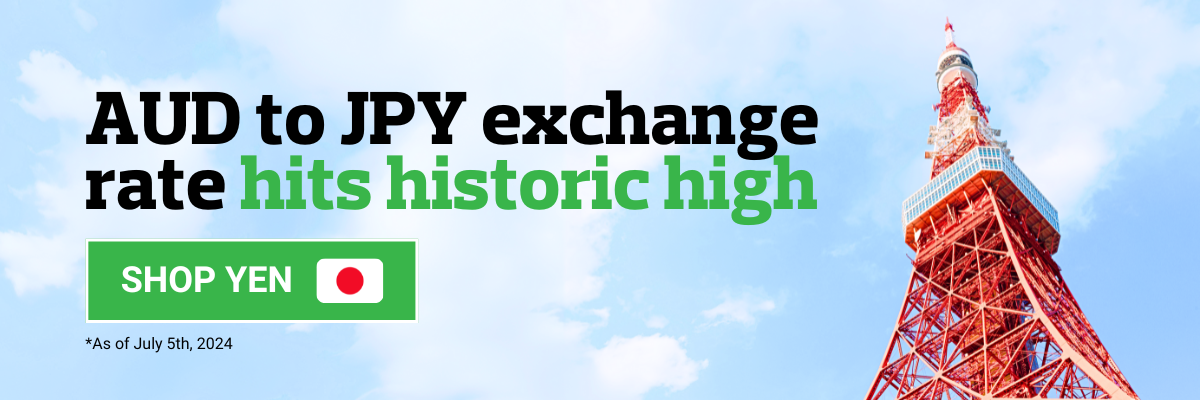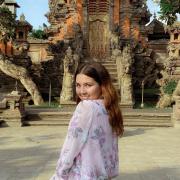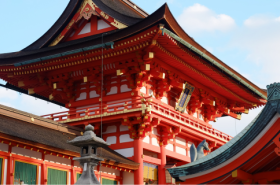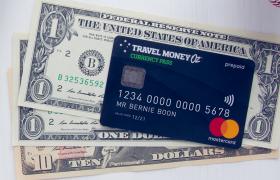There are a few standout changes for the new Japanese Yen design, from holograms, to new historic figures, famous artworks and symbolism, and changes to help the visually impaired.
Hologram
The portraits of the historical figures featured on the new Japanese Yen notes appear to turn their heads depending on the viewing angle!
On top of this, the hologram patterns will also change depending on the viewing angle – as shown in this diagram above (banknote images from the Bank of Japan).
This is a counterfeit prevention technique believed to be the first in the world.
Larger Numerals
To help the aging population, tourists unaccustomed to the currency, and people with visual impairments, the new design has a much more prominently displayed value in Arabic numerals.
The new notes are also more visually different, with different placements for the values, new shapes for the hologram windows, and the colours also are more distinct, to make it easier to distinguish the notes from one another.
New Historical Figures and Artworks
We’ve broken it down below by note:
New ¥10,000 note: Eiichi Shibusawa
The new face of ¥10,000 yen note features famous industrialist Eiichi Shibusawa – a key figure in building Japan’s modern economy, and known as the
“Father of Japanese Capitalism.”
Following the Meiji Restoration, Shibusawa found success as a high-ranking official in the Ministry of Finance before becoming a renowned businessman, helping to establish more than 500 companies in his time, including the famous Sapporo Brewery, and Tokyo’s Imperial Hotel, as well as Japan’s first National Bank (now known as Mizuho Bank). He was a pioneer in banking, introducing joint-stock corporations and double-entry bookkeeping to Japan, and created the predecessors of the Tokyo Stock Exchange and Tokyo Chamber of Commerce. Shibusawa was also a strong advocate for education, helping establish multiple schools – including women’s higher education with Japan Women’s University.
The reverse side of the ¥10,000 yen note features the Tokyo train station building.
TRAVEL MONEY TIP
Think of Japanese Yen in terms of
cents rather than
dollars… meaning, move the decimal place (or just cover up) the last two zeros and you have a rough equivalent in dollars!
So, for the ¥10,000… if you take off the last two zeroes, it’s roughly $100 AUD (depending of course on the exchange rate at the time).
Plus, it has that tint of green - similar to the Aussie $100 bill!
While it’s not an exact science, it helps give a framework to do those mental calculations and keep track of your spending overseas.
New ¥5,000: Umeko Tsuda
The new face of ¥5,000 yen note features Umeko Tsuda – who famously paved the way for Japanese women’s education. When only six years old, Tsuda’s father sent her to the United States as one of the first female students from Japan to study abroad. She lived with a host family in Washington DC until she moved back to Japan at 18 – experiencing intense culture shock at society’s prejudice against women. Finding work as a tutor, Tsuda was dismayed by the way education curriculum framed women to become ‘good wives and mothers,’ and devoted the rest of her life to improving women’s opportunities to receive higher education – going on to found one of the first private institutions for higher education in Japan: then known as Joshi Eigaku Juku. Now known as Tsuda University, it is considered one of the best universities in Japan.
The reverse side of the ¥5,000 yen note features wisteria flowers – a cherished flower beloved for centuries, bringing good luck, kindness, and longevity. It’s also said to ward away demons!
TRAVEL MONEY TIP:
Using the same tip from before, cover the last two zeros and you can see it’s roughly $50 AUD.
New ¥1,000: Shibasaburo Kitasato
The new face of ¥1,000 yen note features scientist Shibasaburo Kitasato – a Nobel-prize nominated physician and bacteriologist who was instrumental in the field of infectious disease prevention. Kitasato was the first person in the world to grow a pure culture of tetanus, and he helped produce a treatment for the disease alongside German physiologist Emil von Behring. They also developed antitoxins for diphtheria and anthrax. For this work, both were nominated for the first Nobel Prize in Medicine, however the prize only went to Behring.
The reverse side of the ¥1,000 yen note features one of the most famous woodblock prints in art history: In the Well of the Great Wave off Kanagawa by Ukiyo-e master Katsushika Hokusai.
TRAVEL MONEY TIP:
Using the same tip from before, cover the last two zeros and you get the approximate equivalent of a $10 note! Plus, it’s blue, just like an Aussie tenner.

